BLOG
*** This page might not be translated. ***
![]()
2017-07-17 22:18
Typical Homemade Miso making
When I was a child, living on the Sadamisaki peninsula, the main crops grown around my village were wheat and sweet potatoes. The land here, used for the growing of crops, is mostly terraced and therefore is not suitable for growing rice.
In addition to farming wheat and sweet potatoes, farm women would also make Miso for their families.
Once, most farming families here would make miso at their house. However it takes a long time to prepare and make and therefore now fewer families go to the trouble of making their own. Instead they buy it ready made from the supermarket as it is easier and takes less time.
There are however 4 women here who still make their own miso at home using the same recipe that was used by their mothers. They want to pass on the method of making miso they use to the next generation to ensure the knowledge will not be lost.
During the summer they come to Ogata san’s house to make miso together. The miso they make is a little sweeter than other miso and is characteristic of miso made in this area.
This is how it is made:
Ingredients
Wheat (Barley)
Rice (non-glutinous rice)
Rice mould (koji)
Soya Beans
Salt
The Method
On the First Day, wash the wheat and the non-glutinous rice then pour them into a colander to drain.
Then pour them into a steamer and cover with a cloth. Steam for about 10-15 minutes.
Next take off the heat and empty onto a straw mat. Mix by hand and allow to cool.
Add the rice mould and stir well. Cover the mixture with paper and place under a futon for warmth and fermentation.











On the Second Day, after the mix has fermented for 24 hours stir again and leave to ferment for another day.
Put the beans into soak ready to use on day 3.


On the Third Day, cook the beans until they become soft, then mince them into a paste.
Mix the beans, fermented wheat and rice in a container. Crush them well to make sure there is no air trapped inside the mixture. Then place the mixture in a preservative type container. Cover the mixture with salt to protect it from deteriorating and to keep its colour and then seal the lid.
After a few weeks it will be ready to use.
In conclusion, the 3 days I spent with these ladies making miso was very enjoyable, as well as being educational. It was so nice to work together just as families and neighbours did in the past.





Typical “Village Food” using Miso.
Method:
1. Grill the fish and separate the meat and the bones.
2. Put the meat, Miso and some peanuts into a brender and brend well.
3. Make soup with the fish bones and add to the mixture.
4. Pour the soup mixture onto rice and garnish with chopped leek and sesame.






When I was a child, living on the Sadamisaki peninsula, the main crops grown around my village were wheat and sweet potatoes. The land here, used for the growing of crops, is mostly terraced and therefore is not suitable for growing rice.
In addition to farming wheat and sweet potatoes, farm women would also make Miso for their families.
Once, most farming families here would make miso at their house. However it takes a long time to prepare and make and therefore now fewer families go to the trouble of making their own. Instead they buy it ready made from the supermarket as it is easier and takes less time.
There are however 4 women here who still make their own miso at home using the same recipe that was used by their mothers. They want to pass on the method of making miso they use to the next generation to ensure the knowledge will not be lost.
During the summer they come to Ogata san’s house to make miso together. The miso they make is a little sweeter than other miso and is characteristic of miso made in this area.
This is how it is made:
Ingredients
Wheat (Barley)
Rice (non-glutinous rice)
Rice mould (koji)
Soya Beans
Salt
The Method
On the First Day, wash the wheat and the non-glutinous rice then pour them into a colander to drain.
Then pour them into a steamer and cover with a cloth. Steam for about 10-15 minutes.
Next take off the heat and empty onto a straw mat. Mix by hand and allow to cool.
Add the rice mould and stir well. Cover the mixture with paper and place under a futon for warmth and fermentation.











On the Second Day, after the mix has fermented for 24 hours stir again and leave to ferment for another day.
Put the beans into soak ready to use on day 3.


On the Third Day, cook the beans until they become soft, then mince them into a paste.
Mix the beans, fermented wheat and rice in a container. Crush them well to make sure there is no air trapped inside the mixture. Then place the mixture in a preservative type container. Cover the mixture with salt to protect it from deteriorating and to keep its colour and then seal the lid.
After a few weeks it will be ready to use.
In conclusion, the 3 days I spent with these ladies making miso was very enjoyable, as well as being educational. It was so nice to work together just as families and neighbours did in the past.





Typical “Village Food” using Miso.
Method:
1. Grill the fish and separate the meat and the bones.
2. Put the meat, Miso and some peanuts into a brender and brend well.
3. Make soup with the fish bones and add to the mixture.
4. Pour the soup mixture onto rice and garnish with chopped leek and sesame.






![]()
2017-06-25 08:59
Tasha Tudor is an American writer best known for her illustrations and writing of children’s fairytale books. She is also remembered and admired by gardeners all over the world for her sedate life style and was the inspiration for “slowlife”.
In Sadamisaki there is a natural garden situated almost in the centre of the peninsula in the Komo district. The area has been developed by the Daiwa House Co. who have also developed 14 other resorts in Japan with the slogan “slowlife”. In Komo people from all over Japan have come and built houses of character as their second homes.
Mr. and Mrs. Otoshi came to Komo 17 years ago. They bought almost 1000 Tsubo (approximately 3,300m²) and built their ideal house and created a beautiful garden there. It took a long time preparing the rough ground and cutting down the trees and grass. They then began the planting to produce the garden we see today. Now, like Tasha Tudor, they can enjoy a wonderful sedate lifestyle.
They open their garden and welcome visitors to view the beauty that has been created. Their wish is that anyone who visits will be able to relax and forget their busy lives, even if only for a short time.
Mrs. Otoshi has a vast knowledge of plants, knowing not only their formal names but also their local names. Since coming to Sadamisaki she has walked in many locations on the peninsula and enjoyed the countryside. During walks in her garden, visitors enjoy stories about her plants and some of her experiences.
It is wonderful to see the changes that occur in nature as the seasons change and as they change through the day from morning to evening and also in the different weather conditions. It is also wonderful to see and hear the many birds that come to visit the garden.
The location of the garden is almost at the top of a mountain. It is surrounded by breathtaking scenery of the land as well as the sea. Visiting the garden gives people a chance to see another part of the peninsula and its surroundings.
Why not come and visit this beautiful garden. Bring tea and lunch and your favourite book and experience a day of “slow life”.
At the gate, a few panels of Tasha Tudor welcome you and approach to the garden
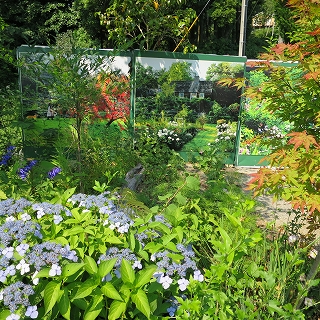

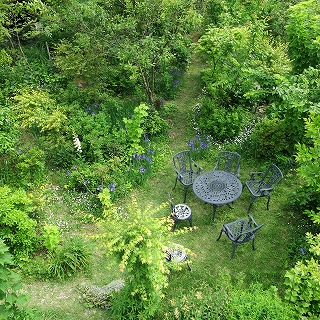

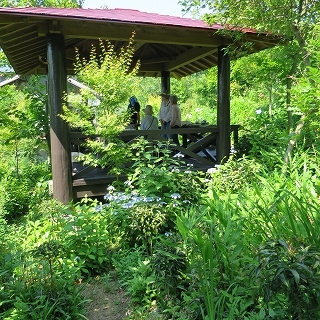
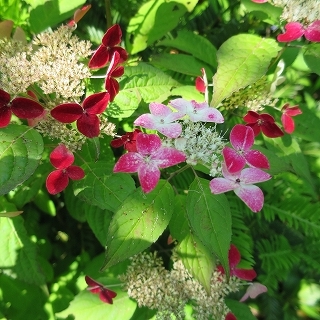
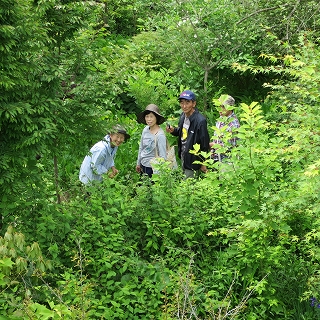
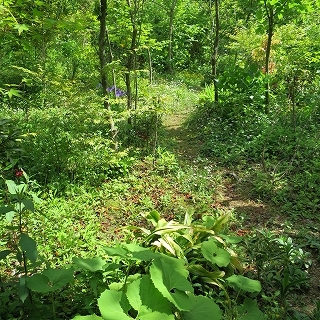


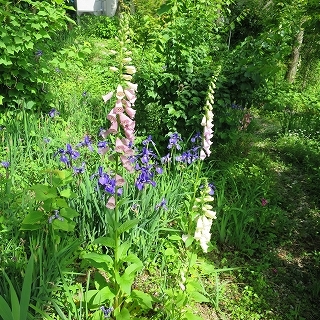
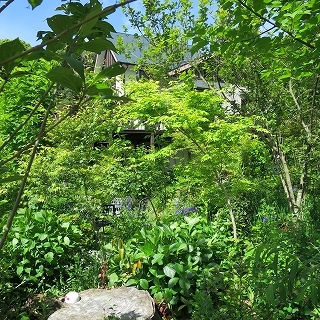
In Sadamisaki there is a natural garden situated almost in the centre of the peninsula in the Komo district. The area has been developed by the Daiwa House Co. who have also developed 14 other resorts in Japan with the slogan “slowlife”. In Komo people from all over Japan have come and built houses of character as their second homes.
Mr. and Mrs. Otoshi came to Komo 17 years ago. They bought almost 1000 Tsubo (approximately 3,300m²) and built their ideal house and created a beautiful garden there. It took a long time preparing the rough ground and cutting down the trees and grass. They then began the planting to produce the garden we see today. Now, like Tasha Tudor, they can enjoy a wonderful sedate lifestyle.
They open their garden and welcome visitors to view the beauty that has been created. Their wish is that anyone who visits will be able to relax and forget their busy lives, even if only for a short time.
Mrs. Otoshi has a vast knowledge of plants, knowing not only their formal names but also their local names. Since coming to Sadamisaki she has walked in many locations on the peninsula and enjoyed the countryside. During walks in her garden, visitors enjoy stories about her plants and some of her experiences.
It is wonderful to see the changes that occur in nature as the seasons change and as they change through the day from morning to evening and also in the different weather conditions. It is also wonderful to see and hear the many birds that come to visit the garden.
The location of the garden is almost at the top of a mountain. It is surrounded by breathtaking scenery of the land as well as the sea. Visiting the garden gives people a chance to see another part of the peninsula and its surroundings.
Why not come and visit this beautiful garden. Bring tea and lunch and your favourite book and experience a day of “slow life”.
At the gate, a few panels of Tasha Tudor welcome you and approach to the garden












![]()
2017-06-03 17:06
The Sadamisaki lighthouse was 100 years old on the 1st April 2017.
To celebrate the anniversary of the building of the lighthouse and the connecting of the small island of Mikagoshima to the peninsula, the local government arranged for a monument to be built. They also wanted to promote the Sadamisaki peninsula and the town. It is only a short distance between the Sadamisaki lighthouse, on Shikoku and the Kanzaki lighthouse at Saganoseki on Kyushu. Shipping passing through this narrow strait increased with the growing prosperity of the late 19th century. In 1901the Kanzaki lighthouse was built followed later by the Sadamisaki lighthouse. The Hoyo strait, as it is called, is also known as the “Hayamizu no Seto” which means “the strait with rapid current”. The strait has many dangerous rocks which is an added difficulty for shipping.
The length of the Sadamisaki peninsula is about 13Ri (Ri is the old Japanese measurement that was used in the past.) which is approximately 52km. It is a beautiful drive along route197 to reach the port of Misaki. The road from Misaki to the lighthouse car park is winding and the journey will take about 30 minutes. Leaving the car park on foot along a natural trail you will reach the lighthouse in about 20 minutes. The trail is, at times, steep and undulating with beautiful views along the way. Trees shade the path bordered with plants and shrubs. The Pacific Ocean and the Setonaikai (Inland Sea) can be seen at times each side of the vista. The final climb is to the top of the lighthouse itself, where you are rewarded by the amazing panoramic view which I have enjoyed many times over the years.
Trail to the lighthouse

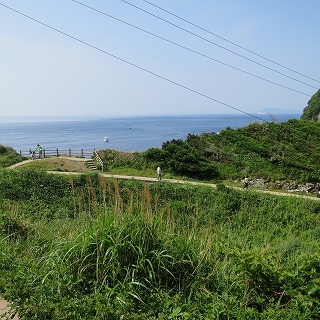


I found my last visit even more impressive as the day was so clear. To the right side, the island of Mikagoshima can be seen with the lighthouse standing beautifully strong and brave before me. In the distance Saganoseki and Beppu in Kyushu could be seen across the straits.
The monument built by the local government that stands on the island of Mikagoshima is called “Forever Light”. There are other signs here to remind us of the past. Scars left by the Second World War and an artillery battery can be seen. These batteries and observation posts were built between the late Taisho and the early Showa period. Across the Setonaikai on Honshu is Kure, where warships were built and was a target for attack by enemy aircraft. My parents told me they saw many planes flying over the Sadamisaki peninsula, probably on their way to attack Kure during the war.
In 2015 a project called “The Lighthouse in Lover” began to promote tourism to the coastal areas by both the Romantic Association of Japan and The Japan foundation. The Sadamisaki lighthouse, because of its beauty, was chosen as one of the 21 lighthouses selected by The Romantic Association of Japan. The lighthouse was also chosen as one of 100 best lighthouses from a survey of people from all over Japan carried out by the Japan Coast Guard. I wonder why people here don’t realize that the Sadamisaki peninsula they live on, which is part of one of Japan’s National Parks, surrounded by breath-taking scenery is such a wonderful place to live and that they should be very proud to live here. I want to promote this area and hope to encourage others to come here and share the beauty that we have.
To Mikago Island
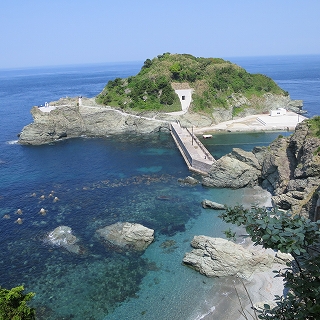

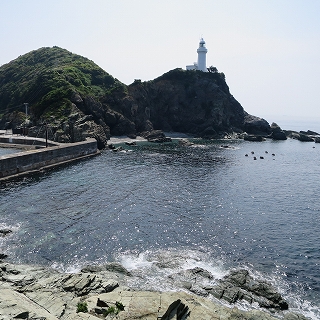

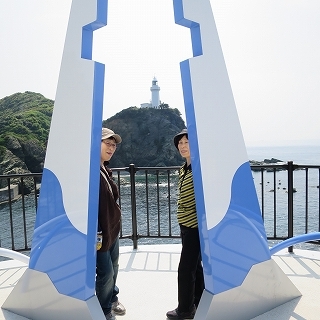
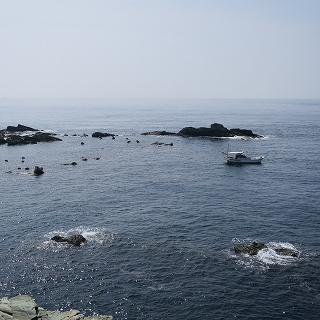

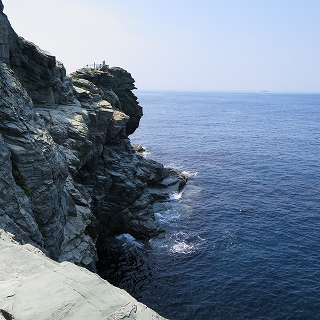
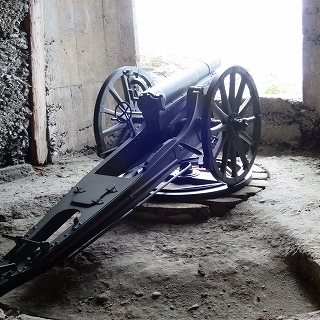
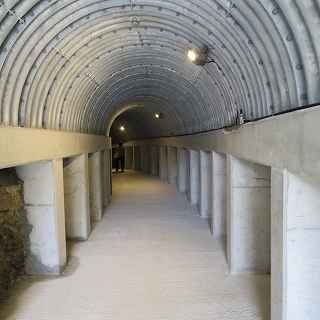
At the observation platform of the ligthouse
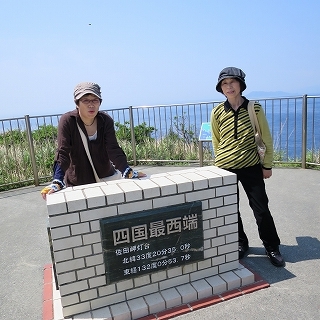
To celebrate the anniversary of the building of the lighthouse and the connecting of the small island of Mikagoshima to the peninsula, the local government arranged for a monument to be built. They also wanted to promote the Sadamisaki peninsula and the town. It is only a short distance between the Sadamisaki lighthouse, on Shikoku and the Kanzaki lighthouse at Saganoseki on Kyushu. Shipping passing through this narrow strait increased with the growing prosperity of the late 19th century. In 1901the Kanzaki lighthouse was built followed later by the Sadamisaki lighthouse. The Hoyo strait, as it is called, is also known as the “Hayamizu no Seto” which means “the strait with rapid current”. The strait has many dangerous rocks which is an added difficulty for shipping.
The length of the Sadamisaki peninsula is about 13Ri (Ri is the old Japanese measurement that was used in the past.) which is approximately 52km. It is a beautiful drive along route197 to reach the port of Misaki. The road from Misaki to the lighthouse car park is winding and the journey will take about 30 minutes. Leaving the car park on foot along a natural trail you will reach the lighthouse in about 20 minutes. The trail is, at times, steep and undulating with beautiful views along the way. Trees shade the path bordered with plants and shrubs. The Pacific Ocean and the Setonaikai (Inland Sea) can be seen at times each side of the vista. The final climb is to the top of the lighthouse itself, where you are rewarded by the amazing panoramic view which I have enjoyed many times over the years.
Trail to the lighthouse




I found my last visit even more impressive as the day was so clear. To the right side, the island of Mikagoshima can be seen with the lighthouse standing beautifully strong and brave before me. In the distance Saganoseki and Beppu in Kyushu could be seen across the straits.
The monument built by the local government that stands on the island of Mikagoshima is called “Forever Light”. There are other signs here to remind us of the past. Scars left by the Second World War and an artillery battery can be seen. These batteries and observation posts were built between the late Taisho and the early Showa period. Across the Setonaikai on Honshu is Kure, where warships were built and was a target for attack by enemy aircraft. My parents told me they saw many planes flying over the Sadamisaki peninsula, probably on their way to attack Kure during the war.
In 2015 a project called “The Lighthouse in Lover” began to promote tourism to the coastal areas by both the Romantic Association of Japan and The Japan foundation. The Sadamisaki lighthouse, because of its beauty, was chosen as one of the 21 lighthouses selected by The Romantic Association of Japan. The lighthouse was also chosen as one of 100 best lighthouses from a survey of people from all over Japan carried out by the Japan Coast Guard. I wonder why people here don’t realize that the Sadamisaki peninsula they live on, which is part of one of Japan’s National Parks, surrounded by breath-taking scenery is such a wonderful place to live and that they should be very proud to live here. I want to promote this area and hope to encourage others to come here and share the beauty that we have.
To Mikago Island










At the observation platform of the ligthouse

![]()
2017-05-26 19:41
The peninsula area boasts shirasu (or sardine fry) fishing and its processing industry. Looking out from my house in the early morning I can see many small fishing boats of three factories heading off to catch sardines.
In my village there are two processing factories, Kijima Suisan and Tanaka Suisan, which are both small family businesses. Their local workers sort the catch carefully by hand. Boiled sardines are then spread out over nets to dry in the sun. The Asahi Kyouhan factory in the next village, on the other hand, is one of the largest in this area supplying to outlets all over Japan.
On a beautiful day in May, I went sardine fry fishing with a help of Kijima Suisan. It was a new experience for me. The view of the peninsula from the boat was wonderful. The blue sea was sparkling with white crests to the little waves. There were seagulls flying above. In the background the fresh green peninsula dotted with small villages reached out into the sea. It was like a scene from a movie.
The boats work in groups of three, two laying the nets the other taking the catch back to harbor. The fishermen worked effectively together as a team, clad in their colored work clothes respectively matching with their weathered sunburned skin and blue sea. The day I went, there were many buto (jellyfish) caught in the nets. These had to be removed to leave the transparent sardine fries. I found fresh ones very appetizing and they made me feel hungry.
Not long ago our area suffered bad catch and there was little work for factory workers. But now with a bountiful catch, life is too busy as they work hard to the extent that they get tired. The height of fishing season is between April and November. Fishing is prohibited during February in my village to allow nature to replace the fish stocks. It is not easy to make a living on fishing in workings of nature. I believe that they are grateful for the benefits which nature has bestowed upon them. We are also grateful to them for providing us with this food from nature.
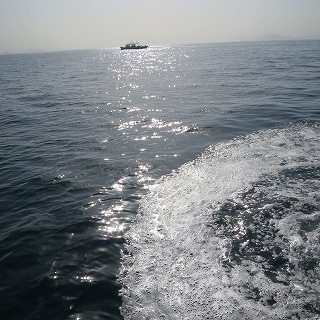


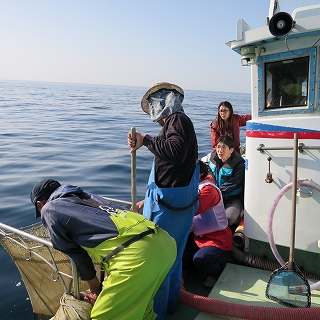
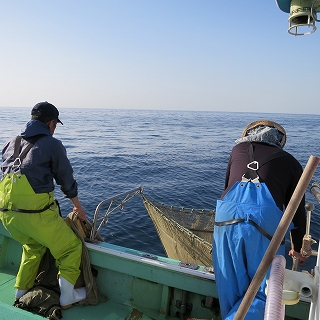

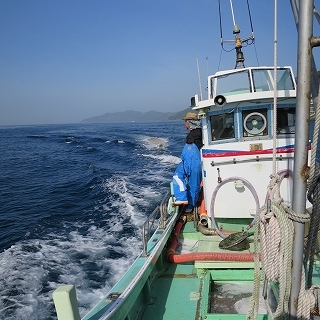

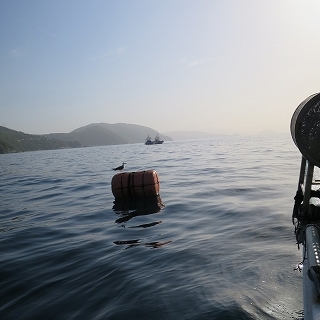
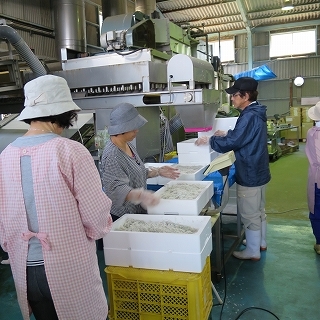
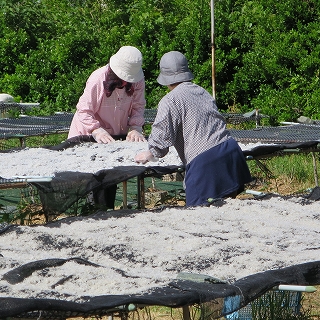

In my village there are two processing factories, Kijima Suisan and Tanaka Suisan, which are both small family businesses. Their local workers sort the catch carefully by hand. Boiled sardines are then spread out over nets to dry in the sun. The Asahi Kyouhan factory in the next village, on the other hand, is one of the largest in this area supplying to outlets all over Japan.
On a beautiful day in May, I went sardine fry fishing with a help of Kijima Suisan. It was a new experience for me. The view of the peninsula from the boat was wonderful. The blue sea was sparkling with white crests to the little waves. There were seagulls flying above. In the background the fresh green peninsula dotted with small villages reached out into the sea. It was like a scene from a movie.
The boats work in groups of three, two laying the nets the other taking the catch back to harbor. The fishermen worked effectively together as a team, clad in their colored work clothes respectively matching with their weathered sunburned skin and blue sea. The day I went, there were many buto (jellyfish) caught in the nets. These had to be removed to leave the transparent sardine fries. I found fresh ones very appetizing and they made me feel hungry.
Not long ago our area suffered bad catch and there was little work for factory workers. But now with a bountiful catch, life is too busy as they work hard to the extent that they get tired. The height of fishing season is between April and November. Fishing is prohibited during February in my village to allow nature to replace the fish stocks. It is not easy to make a living on fishing in workings of nature. I believe that they are grateful for the benefits which nature has bestowed upon them. We are also grateful to them for providing us with this food from nature.












![]()
2017-04-28 22:34
Almost at the center of the Sadamisaki peninsula is the village of OHE, with a commanding view of the “Inland Sea", called “Setonaikai” in Japanese.
The village of Ohe is located on this side of the Inland Sea, on the Sadamisaki peninsula, along one of the many beautiful deep bays that line the coast.
Compared to the ocean on the Pacific side, whose color is bright blue with quiet waters, the sea of Setonaikai is a deep green color with rough waters.
Near this coast in a very traditional Japanese house lives a married couple, whose life revolves around the daily life of the village. They work together to promote
the natural beauty of the Sadamisaki area through international exchange, with the husband tending a grove of “heritage Tangerines”, and his wife creating a beautiful garden. The driftwood they find near the sea adorns various parts of the garden, making it both a functioning garden and a work of art. Their dream is for people to visit their coastal village and enjoy a simple “bento-box” lunch and tea, while enjoying the many natural beauties of the area.


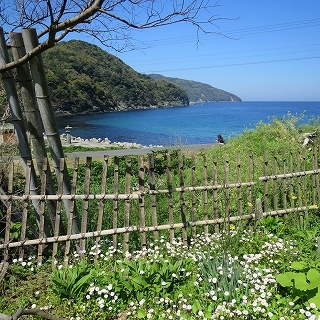

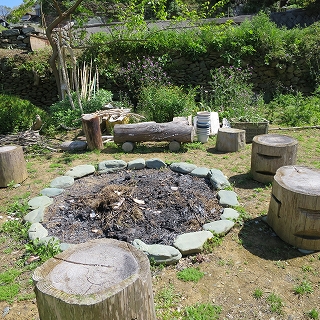
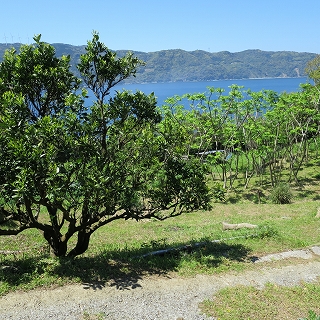
The village of Ohe is located on this side of the Inland Sea, on the Sadamisaki peninsula, along one of the many beautiful deep bays that line the coast.
Compared to the ocean on the Pacific side, whose color is bright blue with quiet waters, the sea of Setonaikai is a deep green color with rough waters.
Near this coast in a very traditional Japanese house lives a married couple, whose life revolves around the daily life of the village. They work together to promote
the natural beauty of the Sadamisaki area through international exchange, with the husband tending a grove of “heritage Tangerines”, and his wife creating a beautiful garden. The driftwood they find near the sea adorns various parts of the garden, making it both a functioning garden and a work of art. Their dream is for people to visit their coastal village and enjoy a simple “bento-box” lunch and tea, while enjoying the many natural beauties of the area.










